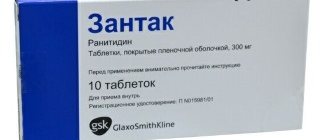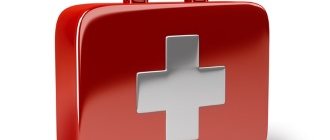pharmachologic effect
The tablets contain a medicinal substance that is a derivative of 1,4-benzodiazepine and has sedative , anticonvulsant and anxiolytic effects.
The action of the active substance is associated with the receptor complex. It includes gamma-aminobutyric acid, GAM-A receptor, benzodiazepine receptor and chloride channel. The active substance inhibits several structures in the central nervous system, in particular the spinal column, limbic system, cerebral cortex, hypothalamus and cerebellum. This substance has a strong anxiolytic effect, hypnotic and sedative activity, reduces the severity of seizures and the tone of skeletal muscles.
Relium in ampoules has hypnotic, anticonvulsant, sedative and anxiolytic effects. The action of the active substance is to influence GABA-A receptors and gamma-aminobutyric acid, which is an endogenous neurotransmitter involved in inhibition processes in the central nervous system. When using the solution, patients experience a decrease in seizures and slight relaxation of skeletal muscles. It also has some hypnotic effects.
Contraindications
Relium is contraindicated in:
- Severe chronic hypercapnia;
- Respiratory disorders of central origin;
- Glaucoma;
- Impaired consciousness;
- Dizziness;
- Myasthenia gravis;
- Balance disorders;
- There is a history of indications of drug or alcohol dependence (the exception is acute withdrawal);
- Depressive states with suicidal tendencies;
- Hypersensitivity to the components of the drug and other benzodiazepines.
Regarding the use of Relium in pediatrics, the drug is not recommended for use in newborns. This is due to the fact that the enzyme system involved in the metabolism of diazepam in children at this age is not yet fully formed.
Relium is not used in the first trimester of pregnancy. The exception is in cases of extreme necessity. However, it should be remembered that diazepam can significantly change the heart rate of the fetus.
In cases where a nursing woman is recommended to regularly take Relium according to indications, breastfeeding should be stopped.
Caution should be exercised when prescribing Relium to patients with:
- Respiratory or heart failure and organic brain damage (in these cases, only the tablet form of the drug should be prescribed);
- Myasthenia;
- Angle-closure glaucoma or a predisposition to it.
Pharmacodynamics and pharmacokinetics
Bioavailability after oral administration is 98 percent. The maximum level of the active substance in the serum is observed after 0.9-1.3 hours and is 500 ng/ml. The main part of the active substance in the serum is in bound form. The half-life lasts up to two days. Diazepam penetrates the blood-brain and blood-placental barriers, and is also detected in small amounts in breast milk. Metabolization occurs in the liver and is excreted through the urinary system.
When administered by injection, high concentrations of the active substance are observed in amniotic and synovial fluids, as well as in breast milk. This substance tends to accumulate in adipose tissue and is subsequently released into the bloodstream. Approximately 25 percent is excreted unchanged.
Reviews about the application
Reviews of people who directly take Relium and use it in daily clinical practice are presented below.
Doctors
Experts generally speak positively about the drug:
- Evgenia Marenkova, psychiatrist: “Relium is based on a component that is the main one, according to the approved local protocols for providing care to patients. I prescribe it because it combines many positive qualities. First, efficiency. Secondly, ease of use. Thirdly, affordability. I see excellent dynamics in patients during treatment with this drug and am ready to recommend it for regular use.”
- Alexander Sviridov, narcologist: “The drug is new to me and little studied in the practice of a narcological hospital. I’m used to using Diazepam, and, if necessary, Sibazon. I don’t see any point in switching to prescribing another medication, since these are effective and show excellent clinical data.”
Patients
Patient reviews are quite varied:
- Angelica Demina: “I suffer from frequent anxiety states. I periodically undergo treatment in the department of a psychiatric hospital. During my last hospitalization, my doctor advised me to start treatment not with my usual medication, but with Relium. He convinced me of the effectiveness of therapy. To be honest, I didn’t believe it because I didn’t know anything about this medicine. After reading the information on the Internet, I was pleasantly surprised by the large number of positive reviews. I tested the positive qualities of Relium on myself. I advise everyone".
- Vasily Vyatkin: “I am satisfied with the Relium treatment regimen prescribed by my doctor. I have suffered from epilepsy since birth. I tried many medications. I won’t say that Relium is the best of all, but it’s not the worst either. The effect was and remained for quite a long time. I didn’t like the presence of side symptoms. I got them literally after two days of taking them. We adjusted the daily dose, and everything went away. I have a neutral attitude towards this drug.”
Today, most specialists consider Relium as the drug of first choice in the treatment of both psychotic disorders and convulsive syndromes of various origins. However, its use in real clinical practice is limited by the relatively low level of information doctors have about it and their adherence to more classical drugs. It is important that its use is cost-effective, since it allows not only to reduce the frequency of relapses and readmissions of patients to a psychiatric hospital, but also, in some cases, to improve the social functioning of such people. Also, in addition to everything, the drug is effective for all forms of psychosis and other psychiatric disorders.
Indications for use of Relium
Indications for use are as follows:
- neuroses , anxiety , restlessness , borderline states with manifestations of tension;
- tetanus , premature placental abruption, premature birth , facilitation of labor;
- premedication before anesthesia;
- status epilepticus;
- arthritis , bursitis , myositis , which are accompanied by tension in the skeletal muscles, spastic conditions that are associated with damage to the spinal cord and brain;
- withdrawal syndrome in chronic alcoholism, motor excitation of various etiologies in psychiatry and neurology, sleep disorders;
- cardioversion.
Side effects
When using Relium, drowsiness, muscle weakness and fatigue are often observed, which spontaneously disappear after a couple of days. Other unwanted effects may also occur:
- allergic reactions: anaphylactic reactions, rash , itching and urticaria ;
- drug addiction;
- ECG changes, hyperhidrosis , convulsions , pain in joints, bones and muscles, increased risk of fractures, respiratory failure , liver dysfunction, increased activity of liver enzymes, jaundice , urinary incontinence or retention;
- bowel disturbances, nausea , colic , dry mouth or hypersalivation , vomiting , anorexia ;
- decreased visual acuity, vertigo , diplopia ;
- changes in blood composition, neutropenia ;
- confusion , emotional poverty, depression , decreased attention, deviant behavior , nightmares , psychosis , hostility, irritability , anxiety , hallucinations , agitation ;
- anterograde amnesia (with high doses of diazepam), anger, aggression , disorientation , dizziness , speech , tremor , headache , mood lability, loss of consciousness , dysarthria ;
- heart failure (up to cardiac arrest), arterial hypotension , bradycardia , circulatory failure, chest pain.
General information about the drug Relium
Relium is a standard psycholeptic of European quality. It is produced in Warsaw (Poland) at the Polfa pharmaceutical concern. The medication has a combined effect, providing anticonvulsant and sedative effects. The drug is on the list recommended for availability in medical institutions compiled by the World Health Organization.
Drug group, INN, scope of application
Relium belongs to the pharmacological group of psycholeptic drugs, a subgroup of anxiolytics, benzodiazepine derivatives. A special feature of this group is that all drugs included in its composition are sold strictly according to prescription. International nonproprietary name (INN) is Diazepam.
The drug is actively used in psychiatric, neurological and drug addiction practices. It can also be used in selected clinical cases of infectious diseases.
Release forms
Available in the form of film-coated tablets. Each tablet is round, biconvex, yellow in color. Dosage is exclusively 5 mg.
The price of medicine in Russian pharmacies differs slightly.
| A drug | Pharmacy name, city | Price in rubles |
| Relium 5 mg, No. 20 | APTEKA LLC, St. Petersburg | 40 |
| Pharmaceutical Leasing LLC, St. Petersburg | 39 | |
| WER.RU, Moscow | 31.9 | |
| Farmalizing LLC, St. Petersburg | 27.5 | |
| Apteka.ru, Smolensk | 31 | |
| Low price pharmacy, Moscow | 33 | |
| Apteka.ru, Orel | 3410 | |
| Laboratory of beauty and health, Moscow | 38 | |
| Online pharmacy GORZDRAV, Moscow and region | 30 |
Instructions for use of Relium (Method and dosage)
According to the instructions for use of Relium, tablets are taken regardless of food, the dose is selected individually for each patient.
As a rule, in most cases for anxiety conditions, 1 tablet per day is prescribed. The maximum dose is 30 milligrams per day. For spastic conditions, 5 to 15 milligrams per day are prescribed. The maximum dose is 60 milligrams per day. For insomnia associated with anxiety, 5 to 15 milligrams are prescribed. It is recommended to take the medicine 20-30 minutes before bedtime. For premedication , 5 to 20 milligrams of diazepam .
During therapy, it is recommended to use only the minimum doses of the active substance that provide a therapeutic effect (the dose can be increased only in cases where there is a significant need to enhance the effect). It is not advisable to use the full dose more than four times a week.
The maximum duration of treatment is one month, for anxiety conditions - from 8 to 12 weeks (the time for drug withdrawal is included in the periods).
The solution is administered intravenously or intramuscularly. Injections can be done no more often than every 3-4 hours, in extremely severe cases they can be done every hour. The drug must be injected into a vein very slowly, otherwise collapse . Patients over 65 years of age, as well as weakened patients, can be prescribed only minimal doses.
The solution can be administered intravenously only into large veins; intraarterial administration is unacceptable. It can be administered intramuscularly only into large muscles. This medicine can only be administered separately, as it is incompatible with other medicines.
Release form and composition
Dosage forms:
- Solution for intravenous (i.v.) and intramuscular (i.m.) administration: clear or slightly opalescent liquid, colorless to greenish-yellow in color (2 ml in colorless glass ampoules, 5 ampoules per tray, 1 in a cardboard box, 2 or 10 pallets);
- Film-coated tablets (20 pieces in a blister, 1 blister in a cardboard box).
1 ml of solution for intravenous and intramuscular administration contains:
- Active ingredient: diazepam – 5 mg;
- Auxiliary components: sodium benzoate, benzyl alcohol, benzoic acid, ethyl alcohol (96% ethanol), propylene glycol, water for injection.
1 film-coated tablet contains:
- Active ingredient: diazepam – 5 mg;
- Auxiliary components: Tween 80, potato starch, quinoline yellow (E104), magnesium stearate, lactose, gelatin, talc;
- Shell composition: polyethylene glycol 6000, cellulose acetate phthalate.
Overdose
In case of overdose, dysarthria , nystagmus , drowsiness and ataxia . apnea , coma , depression of cardiac and vascular function, and arterial hypotension can also sometimes be observed . In people with diseases of the respiratory system, with an overdose, respiratory depression becomes more pronounced.
Treatment consists of eliminating symptoms, supportive therapy (carrying out artificial respiration (in the absence of consciousness), monitoring the functions of the cardiovascular, nervous and respiratory systems). To reduce the absorption of diazepam, enterosorbents are prescribed (gastric lavage is not recommended).
Interaction
Concomitant use with drugs that depress the central nervous system (including opioid analgesics , hypnotics , sedatives , antipsychotics and anesthetics respiratory center, and also contributes to the development of severe arterial hypotension .
Simultaneous use with ethanol or drugs containing ethanol enhances the inhibitory effect on the central nervous system (especially the respiratory center) and contributes to the development of pathological intoxication syndrome.
Concomitant use with disulfiram , omeprazole , cimetidine increases the intensity and duration of exposure to diazepam.
Concomitant use with fluvoxamine increases plasma concentrations and side effects of diazepam.
Phenytoin and phenobarbital accelerate the metabolism of diazepam, and rifampicin increases its elimination. Paracetamol reduces the excretion of diazepam, and simultaneous use with risperidone promotes the development of NMS.
Simultaneous use with metoprolol leads to a deterioration of psychomotor reactions and a decrease in visual acuity, with lithium carbonate - leads to the development of a coma, with levodopa - suppresses the antiparkinsonian effect, with clozapine - causes loss of consciousness, respiratory depression and severe arterial hypotension, with diclofenac - causes increased dizziness, with bupivacaine - increases its concentration in the blood plasma, with oral contraceptives - enhances the effect of diazepam and can lead to breakthrough bleeding , with muscle relaxants - enhances their effect and increases the risk of apnea , with tricyclic antidepressants (including amitriptyline ) - enhances a depressant effect on the central nervous system, enhances the cholinergic effect and increases the concentration of antidepressants.
Simultaneous use with caffeine reduces the sedative and anxiolytic effects of the drug. Medicines that cause induction of liver enzymes, including anti- epileptic ( phenytoin , carbamazepine ), accelerate the elimination of diazepam.
In people who have been taking cardiac glycosides , anticoagulants , beta-blockers , and antihypertensive drugs , the mechanisms and extent of drug interactions may be unpredictable.
special instructions
In case of organic changes in the brain (it is recommended to avoid parenteral administration), respiratory and heart failure, myasthenia gravis, closed-angle glaucoma or a predisposition to it, diazepam should be used with extreme caution.
Under the supervision of a physician, especially at the beginning of therapy, it is necessary to prescribe the drug against the background of long-term use of beta-blockers, centrally acting antihypertensives, anticoagulants, and cardiac glycosides.
A gradual dose reduction is required when discontinuing Relium, since sudden cessation can cause agitation, anxiety, convulsions, and tremors.
Drinking alcohol during treatment is strictly contraindicated.
If paradoxical reactions occur, diazepam should be discontinued.
With intramuscular administration of the drug, an increase in the activity of creatine phosphokinase in the blood plasma is possible.
Intra-arterial administration is not allowed.
During the period of treatment, you should stop driving vehicles and machinery.
Analogs
Level 4 ATC code matches:
Bromazepam
Helex
Rudotel
Nozepam
Tazepam
Xanax
Elenium
Valium Roche
Alprazolam
Tofisopam
Diazepam
Grandaxin
Mezapam
Sibazon
Seduxen
Relanium
Lorazepam
Analogues are:
- Apaurin;
- Seduxen;
- Diazepam;
- Relanium;
- Valium.





